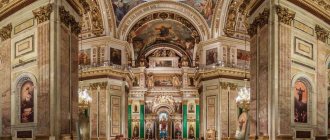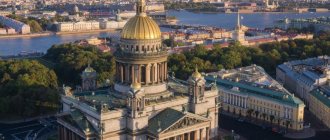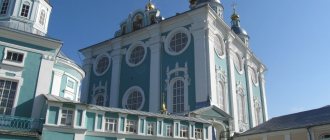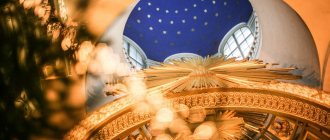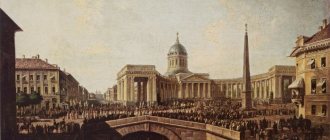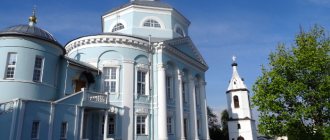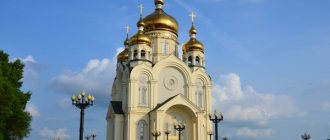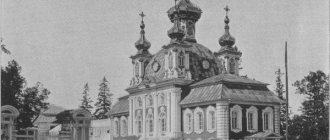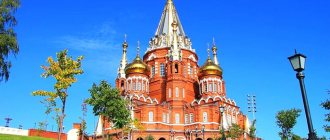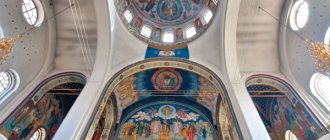"Save me, God!".
Thank you for visiting our website, before you start studying the information, please subscribe to our Orthodox community on Instagram, Lord, Save and Preserve † - https://www.instagram.com/spasi.gospodi/. The community has more than 60,000 subscribers. There are many of us like-minded people and we are growing quickly, we post prayers, sayings of saints, prayer requests, and timely post useful information about holidays and Orthodox events... Subscribe. Guardian Angel to you!
This cathedral has been the hallmark of St. Petersburg for more than 150 years. It is known for its beauty and size. It is considered the calling card of the city. It became famous not only due to such facts, but also because it had to be built four times. Today, St. Isaac's Cathedral is known as one of the tallest domed buildings in the world, and it is also the largest Orthodox church in St. Petersburg. Many people visit it not only as a monument of Orthodoxy. Tourists often enjoy the view of St. Petersburg from St. Isaac's Cathedral.
Where is it located and how to get there?
The golden dome of the cathedral rises to a height of 101 m, is clearly visible from different points of the city and is a landmark for tourists.
St. Isaac's Cathedral is located on the square of the same name in the Admiralteysky District, within walking distance from the monument to Peter I. For those who want to admire the beauty of the cathedral, the most convenient way is to get to the Admiralteyskaya metro station, and then take a short walk (about two blocks).
You can also get to the Nevsky Prospekt or Ploshchad Vosstaniya stations, but they are located further, so you will have to transfer to buses 7, 24, 191 and get to the Admiralteysky Prospekt stop, and then also continue on foot (fortunately, the rest of the route runs through the historical part of St. Petersburg).
Shrines
During the Great Patriotic War, works of art were stored in the basements. To protect the temple from destruction, the dome was painted gray. But shelling could not be avoided. Marks could be seen on the walls and ceiling. Legend has it that they did not shoot at the dome itself, but simply used it as a landmark in the area.
In addition to the paintings on the dome and walls, the temple was also decorated with other shrines:
- a significant part of the relics of St. Andrew the First-Called and a cross with the life-giving tree of the Lord,
- A miraculous image of the Savior with a golden robe and an image of a crown of thorns,
- Tikhvin Icon of the Blessed Virgin Mary,
- Korsun face of the Mother of God.
The best article for you, go to: Cathedral of the Kazan Icon of the Mother of God on Red Square
In 1948, the temple was given museum status. Since 1990, services on holidays and Sundays have been revived. This tradition is still alive today.
Opening hours of the observation deck and ticket price
The St. Isaac's Cathedral Museum-Monument is open to visitors from 10.30 am to 6 pm on all days of the week except Wednesday. During the spring-summer period, guests are also offered evening programs from 18.00 to 22.30.
Please note: the ticket office closes half an hour before the end of the working day, at which time visitors are no longer allowed inside the museum.
And what can you watch in thirty minutes? If you want to slowly enjoy the beauty of the museum, it is better to plan your visit with plenty of time.
The full cost of a ticket to the museum-monument is 250 rubles.
Discount tickets can be purchased for the following categories:
- youth (from 7 to 18 years inclusive) – 50 rubles;
- pensioners - 50 rubles;
- students (graduate students, cadets, etc. of educational institutions) - 50 rubles;
- holders of international ISIC cards – 150 rubles.
Separately, you can visit the Colonnade of the Cathedral (with audio guide services). In this case, the ticket price is 150 rubles. For the convenience of visitors, tickets can be purchased online on the museum’s website.
How to get to the cathedral
The exact address of St. Isaac's Cathedral in St. Petersburg will be needed by those who will travel on their own or use a navigator. The temple is located: St. Petersburg, St. Isaac's Square 4. Many visitors ask the question of how to get to St. Isaac's Cathedral in St. Petersburg. Most people combine a visit to the cathedral with sightseeing such as the Bronze Horseman, Nevsky Prospekt and Palace Square. If you decide to get to St. Isaac’s Cathedral on your own, there are several ways:
- Admiralteyskaya metro station. It is located at the intersection of Kirpichny Lane and Malaya Morskaya. You need to walk 2 blocks to the left along Malaya Morskaya and you will come to St. Isaac's Square with the cathedral.
- Such stations as “Sadovaya”, “Sennaya”, “Spasskaya” go to Sennaya Square. From there you need to walk along Grivtsov Lane to the Moika River embankment. Next, turn left. And after 100 m you will reach your goal.
The best article for you, go to: Annunciation Cathedral, Voronezh
History of creation
The history of the monument dates back to the 18th century, when Emperor Peter I ordered the construction of a temple in honor of St. Isaac of Dalmatia, whom he considered his patron.
The temple was erected in a few months and opened in 1707. The Second St. Isaac's Cathedral was rebuilt to replace the outdated one in 1727. However, eight years later it burned out. The cause of the fire was a lightning strike. Restoration work lasted almost until the middle of the 18th century and was not successful.
After which Empress Catherine II gave the order for the construction of a new cathedral according to the design of A. Rinaldi. It ended in 1802. However, the emperor was not impressed with the result, and he was forced to again announce a competition for architectural projects.
History of construction
The beginning of the history of its origin stretches back to the distant year 1710. Then a wooden church was built in honor of Isaac of Dalmatia. The day of remembrance of this saint falls exactly on the birthday of Peter the Great. In 1712, Peter married his second wife Ekaterina Alekseevna there. Over time, a stone church was built.
The construction of the third temple was completed after the 50-60s of the 18th century. As soon as the construction was over, it immediately became clear that he was disturbing the formal development of the city center. It was then that Emperor Alexander 1 issued a decree on holding a competition for the best option for rebuilding this temple. Almost a decade later, the project of the Frenchman O. Montferrand was approved. From then on, work began to boil.
Construction of a new fourth temple
Construction lasted about 40 years. It took a lot of materials and effort. The result that came out in the end amazed everyone and exceeded all expectations. The square shape of the cathedral emphasizes its monumentality. About 43 varieties of minerals were used in the construction of this temple.
The best article for you, go to: Solovetsky Monastery: history, how to get there, where it is located
Along the entire perimeter there are eight-column porticoes with bas-reliefs and statues. Above the bulk of the cathedral there is a gilded dome on a drum, which is surrounded by granite columns. The dome is cast from metal, but its gilding took about 100 kg of red gold.
Also among the finishing stones used:
- purple,
- jasper,
- marble,
- granite.
Famous architects and artists worked on the interior decoration of the temple. Among them are such famous people as:
- Karl Bryullov,
- Vasily Shebuev,
- Ivan Vitali,
- Fyodor Bruni and many other sculptors and architects.
According to the architect's plan, the cathedral can simultaneously house about 7,000 people. But in reality the number can reach 12,000. The height of the temple reaches 101.5 m. After the revolution, the temple was destroyed. Gold and silver were taken out of it. In 1928, services stopped and an anti-religious cathedral in the country settled in this building.
Interesting facts about the architect and the construction of the cathedral
The winner was a young French architect - O. Montferrand.
O. Montferrand's initial project contained errors and it took the young man some time to correct them and continue construction. The work has been completed. And on the day of Isaac of Dalmatia in 1858, the cathedral was illuminated and until 1929 it was the cathedral of the Russian Orthodox Church.
St. Isaac's Cathedral opening hours - visiting schedule of the State Museum-Monument
One of the main attractions of St. Petersburg, attracting thousands of tourists every day, is St. Isaac's Cathedral - the largest Orthodox church in the northern capital of Russia.
Saint Isaac's Cathedral
In addition to the fact that the cathedral is a religious building where church services are held daily, it is also a museum, the official name of which is the State Museum-Monument “St. Isaac’s Cathedral”.
If you want to get to know this object as fully as possible, see the unique objects located in it, and also learn about its history, you should visit the museum during opening hours. This will allow you not only to admire the temple from the outside, but also to enjoy the beauty of its interiors.
Like other museums, St. Isaac's Cathedral has its own official website, which allows you to get acquainted with all the information regarding this object. Here, among other things, you can see the operating mode.
Official site
Thus, the facility is open to the public from 10.30 to 18.00 every day, except Wednesday. In addition to daytime visits to the temple, visits to museum programs are available, which are organized in the evening (from 18.00 to 22.30). However, such programs are held only in the warm season (from April 27 to September 30).
Please note that the museum ticket office closes 30 minutes earlier. Also, half an hour before the museum closes, visitors are no longer allowed in.
Operating mode
In addition to the museum-monument itself, you can also visit the colonnade of St. Isaac's Cathedral, located around the drum of the central dome, the outer diameter of which exceeds 25 meters. The operating hours of the colonnade coincide with the operating hours of the museum itself. However, you can visit the colonnade every day, including on Wednesdays from May 1 to October 31. Moreover, from November 1 to April 30, the third Wednesday of each month is a day off.
From April 27 to September 30, an evening visit to the colonnade is also available from 6 to 10:30 p.m. The admission of visitors, as well as into St. Isaac's Cathedral itself, stops 30 minutes before the closing of the facility. Then the cash registers also stop working.
Operating mode of the colonnade
The State Museum-Monument "St. Isaac's Cathedral" includes not only the temple itself on St. Isaac's Square, but also another historical site of St. Petersburg. Such is the museum-monument “Savior on Spilled Blood,” the full name of which sounds like the Cathedral of the Resurrection of Christ on Spilled Blood. The facility is located on the embankment of the Griboyedov Canal.
The Savior on Blood Museum-Monument became a branch of the St. Isaac's Cathedral Museum back in 1971. Today the facility's operating mode is as follows. The facility is open from 10.30 to 18 hours every day except Wednesday. There are also evening programs available from April 27 to September 30. The hours of such programs are from 10 to 22.30. You can also visit them on any day, except Wednesday.
Operating hours of the Savior on Spilled Blood
Another object of the state museum-monument is the Stone Museum, whose operating hours are slightly different. Thus, the facility is open to the public from 10 a.m. to 6 p.m. every day from May 1 to September 30. Opening hours are the same from October 1st to April 30th, but the facility is closed the second Wednesday of each month.
The closing of ticket offices and the cessation of admission of visitors also stops half an hour before the specified time.
It is important to note that during school holidays (the only exception is summer holidays), as well as public holidays (except January 1), museum facilities operate seven days a week.
Thus, St. Isaac's Cathedral's operating hours are quite convenient for visitors who can see the object not only during the day, but also in the evening. The temple is also open to visitors all year round, including the cathedral colonnade, which is of considerable interest to tourists, as there is an observation deck here that offers a panoramic view of the central part of St. Petersburg.
Still, it is worth remembering that changes may be made to the museum’s operating hours due to technical or other reasons.
In order to visit the museum-monument, you need to buy tickets at the box office, which stop working half an hour before the museum closes. However, you can purchase tickets not only directly at the box office, but also on the official website. By the way, here you can buy tickets to St. Isaac's Cathedral, the Savior on Spilled Blood, the colonnade of St. Isaac's Cathedral (with an audio tour “Panorama of St. Petersburg”) and the Stone Museum.
To buy a ticket
It is worth noting that, among other things, the cathedral hosts concerts, tickets for which can also be purchased through the official website. Here you can also see a poster indicating the date, time and location of the event.
What are the columns made of?
The cathedral columns decorating the porticoes are made of granite, which was delivered to St. Petersburg from quarries near Vyborg.
Interestingly, the columns also decorate the interior of the temple. Thus, the main altar is decorated with columns lined with malachite and exuding the smell of myrrh.
The oil of this tree was included in a special composition that was used to attach the plates to the base.
Saint Isaac's Cathedral
The latest building of the Classical era, which took four decades to build, starting in 1818, was supposed to belong to the main temple of the Russian state. The Cathedral of St. Isaac of Dalmatia is not the first shrine in the country, but it can definitely be considered one of the most beautiful, unique and grandiose. Monolithic granite columns, marble cladding, reliefs of facades and doors, statues on the roof - already from the outside it amazes and delights with its majestic beauty.
A visit to the inside of the temple will introduce you to the history of its creation and the creators themselves, interesting facts and figures characterizing the structure, the unique decoration with multi-colored natural stone, its impressive scale and special atmosphere.
A walk along the colonnade, accompanied by an audio tour, will reveal a unique view from a 43-meter height. From the end of April to October, visiting is also allowed in the evening hours - you can admire the beautiful panorama until half past ten.
In 1990, after a long break, the Divine Liturgy was celebrated here for the first time. Since 2005, the temple has been permanently operating. Orthodox services are held daily, except for Wednesdays, which are designated as a day off at the museum.
The modern building was built by the architect Auguste Montferrand; it is the fourth version of St. Isaac's Church. Previous churches were built one by one in approximately the same area, falling into disrepair for various reasons and replacing each other. The first was the wedding of Peter I and Catherine. It is precisely the site occupied by the modern cathedral that was first chosen for the construction of its previous version.
Operation as a temple began in 1928. Its first exhibition introduced visitors to the history of the building's construction. In April 1931 the museum became known as the State Anti-Religious Museum. Having existed in this status for six years, it received historical and artistic direction, and the building itself was recognized as a valuable architectural monument.
In the forties, it was in St. Isaac's Cathedral that valuable exhibits of city museums and famous palaces - former country royal residences - were kept from the destructive war. Almost twenty years after its completion, restoration work continued. However, the museum received visitors again in 1948. In 1963, the temple became part of the complex of the State Museum of the History of Leningrad.
Due to its special value, since 1968 it was allocated as a separate museum object, which gradually expanded into a complex that included several St. Petersburg architectural monuments.
St. Isaac's Cathedral is surrounded by other architectural and sculptural monuments of the city, as well as simply in an amazingly beautiful place not far from the Neva.
To get to St. Isaac's Square, you can choose a longer or shorter walk through the historical center - this will determine which of the many metro stations you should prefer. The closest of them is Admiralteyskaya.
Divine services have resumed at St. Isaac's Cathedral in the northern capital after the easing of quarantine measures
St. Petersburg, July 20, 2021
On July 19, 2021, on the 6th Sunday after Pentecost, a divine service was held at St. Isaac's Cathedral in St. Petersburg - the first after the easing of quarantine measures introduced due to the coronavirus pandemic, Patriarchia.ru reports.
The Divine Liturgy was performed by the cathedral's sacristan, Archpriest Alexy Isaev, co-served by the secretary of the administration of the St. Petersburg diocese, Archpriest Sergius Kuksevich, and the cathedral clergy.
From July 19, daily services in the cathedral resume in compliance with the necessary sanitary and epidemiological requirements established by Rospotrebnadzor in connection with the threat of the spread of coronavirus infection. Parishioners will be able to attend the church wearing masks and maintaining social distancing. This time, the parishioners also wore masks, and there was a limit on the number of no more than 30 people.
“Today is our long-awaited day - there were no services for 111 days and, by the grace of God, we lived to see the first service after quarantine,” Archpriest Alexy Isaev said in a conversation with journalists. — All anti-epidemic measures have been taken in the cathedral, masks and gloves have been distributed to parishioners, and temperatures are measured at the entrance. The temple lives by worship, and we are happy that now we have the opportunity to perform it. Divine services will be held daily, morning and evening, excursions will be held for tourists, but at the same time anti-epidemic measures are being taken... By the grace of God, we hope the Lord will arrange for liturgical services, excursion and museum activities to fully resume.”
* * *
Emperor Peter I especially honored St. Isaac of Dalmatia - the emperor’s birthday fell on the saint’s memorial day. Peter I planned to build the Church of St. Isaac of Dalmatia in the new capital, St. Petersburg. The current St. Isaac's Cathedral is the fourth in a row. Built according to the design of the French architect Auguste Montferrand, construction lasted almost 40 years and occurred during the reign of three Russian emperors: Alexander I, Nicholas I and Alexander II. The consecration of the cathedral took place in 1858 with a gathering of many people in the presence of the imperial family. From that moment until the revolution, St. Isaac's Cathedral was the main temple of the Russian Empire and the cathedral of St. Petersburg. In 1928, the temple was closed, three years later an anti-religious museum was opened in it. In 1937, St. Isaac's Cathedral received monument status. The first divine service in St. Isaac's Cathedral after a long break was held in 1990. Since the fall of 2015, morning and evening services have been held daily in the cathedral.
